TurboGrafx-16
The TurboGrafx-16, known in Japan and France as the PC Engine[3], is a cartridge-based home video game console manufactured and marketed by NEC Home Electronics and designed by Hudson Soft. It was released in Japan on October 30, 1987, and in the United States on August 29, 1989. The Japanese model was imported and distributed in France in 1989, and the United Kingdom and Spain received a version based on the American model known as simply TurboGrafx. It was the first console released in the 16-bit era, although it used a modified 8-bit CPU. In Japan, the system was launched as a competitor to the Famicom, but the delayed United States release meant that it ended up competing with the Sega Genesis and later the Super Nintendo Entertainment System.
  | |
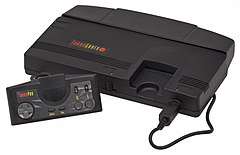 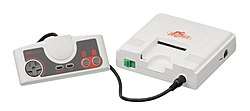 Western markets model (top) and the original Japanese and French system (bottom). | |
| Manufacturer | NEC Home Electronics |
|---|---|
| Type | Home video game console |
| Generation | Fourth generation |
| Release date | |
| Discontinued | |
| Units sold | Worldwide: 5.8 million[2] Japan: 3.9 million |
| Media | HuCard, CD-ROM (only with the CD-ROM² add-on) |
| CPU | Hudson Soft HuC6280 |
| Display | Resolution: - max. 565×242 - majority: 256×239 Colors: - available: 512 (9-bit) - onscreen: max. 482 (241 background, 241 sprite) |
| Dimensions | 14 cm × 14 cm × 3.8 cm (5.5 in × 5.5 in × 1.5 in) |
| Successor | SuperGrafx (upgraded) PC-FX |
The TurboGrafx-16 has an 8-bit CPU, a 16-bit video color encoder, and a 16-bit video display controller. The GPUs are capable of displaying 482 colors simultaneously, out of 512. With dimensions of just 14 cm × 14 cm × 3.8 cm (5.5 in × 5.5 in × 1.5 in), the Japanese PC Engine is the smallest major home game console ever made.[4][5] Games were released on HuCard cartridges and later the CD-ROM optical format with the TurboGrafx-CD add-on.
The TurboGrafx-16 failed to break into the North American market and sold poorly, which has been blamed on the delayed release and inferior marketing.[6] Despite the "16" in its name and the marketing of the console as a 16-bit platform, it used an 8-bit CPU, a marketing tactic that was criticized by some as deceptive.[7]
However, in Japan, the PC Engine, introduced into the market at a much earlier date, was very successful. It gained strong third-party support and outsold the Famicom at its 1987 debut, eventually becoming the Super Famicom's main rival.[8]
At least 17 distinct models of the TurboGrafx-16 were made, including portable versions and those that integrated the CD-ROM add-on.[9]
An enhanced model, the PC Engine SuperGrafx, was rushed to market in 1989. It featured many performance enhancements and was intended to supersede the standard PC Engine. It failed to catch on - only six titles were released that took advantage of the added power and it was quickly discontinued.
The entire series was discontinued in 1994. It was succeeded by the PC-FX, only released in Japan.
History
The TurboGrafx-16 or PC Engine was a collaborative effort between Hudson Soft, who created video game software, and NEC, a company which was dominant in the Japanese personal computer market with their PC-88 and PC-98 platforms. NEC lacked the vital experience in the video gaming industry so approached numerous video game studios for support. By pure coincidence, NEC's interest in entering the lucrative video game market coincided with Hudson's failed attempt to sell designs for then-advanced graphics chips to Nintendo.[10] The two companies successfully joined together to then develop the new system.[5]
The PC Engine made its debut in the Japanese market on October 30, 1987, and it was a tremendous success. The PC Engine had an elegant, "eye-catching" design, and it was very small compared to its rivals.[6] This, coupled with a strong software lineup and third-party support from high-profile developers such as Namco and Konami gave NEC a temporary lead in the Japanese market.[5]
In 1988, NEC decided to expand to the American market and directed its U.S. operations to develop the system for the new audience. NEC Technologies boss Keith Schaefer formed a team to test the system. They found was a lack of enthusiasm in its name 'PC Engine' and also felt its small size was not very suitable to American consumers who would generally prefer a larger and "futuristic" design. They decided to call the system the 'TurboGrafx-16', a name representing its graphical speed and strength, and its 16-bit GPU. They also completely redesigned the hardware into a large, black casing. This lengthy redesign process and NEC's questions about the system's viability in the United States delayed the TurboGrafx-16's debut.[6]
The TurboGrafx-16 was eventually released in the New York City and Los Angeles test market in late August 1989. Disastrously for NEC, this was two weeks after Sega of America released the true 16-bit Genesis to test markets. Unlike NEC, Sega didn't waste time redesigning the original Japanese Mega Drive system.[11][6]
Sega quickly eclipsed the TurboGrafx-16 after its American debut. NEC's decision to pack-in Keith Courage in Alpha Zones, a Hudson Soft game unknown to western gamers, proved costly as Sega packed-in a port of the hit arcade title Altered Beast with the Genesis. NEC's American operations in Chicago were also overhyped about its potential and quickly produced 750,000 units, far above actual demand. This was very profitable for Hudson Soft as NEC paid Hudson Soft royalties for every console produced, whether sold or not. By 1990, it was clear that the system was performing very poorly and severely edged out by Nintendo and Sega's marketing.[6]
After seeing the TurboGrafx-16 suffer in America, NEC decided to cancel their European releases. Units for the European markets were already produced, which were essentially US models modified to run on PAL television sets, and branded as simply TurboGrafx. NEC sold this stock to distributors - in the United Kingdom Telegames released the TurboGrafx in 1990 in extremely limited quantities.[12] This model was also released in Spain and Portugal through selected retailers.[13]
From November 1989 to 1993, PC Engine consoles as well as some of its add-ons were imported from Japan by French licensed importer Sodipeng (Société de Distribution de la PC Engine, a subsidiary of Guillemot International).[14] This came after considerable enthusiasm in the French press. The PC Engine was largely available in France and Benelux through major retailers. It came with French language instructions and also an AV cable to enable its compatibility with SECAM television set. Its launch price was 1,790 French francs.[15]

By March 1991, NEC claimed that it had sold 750,000 TurboGrafx-16 consoles in the United States and 500,000 CD-ROM units worldwide.[16]
However, neither CD-based console would catch on and the North American console gaming market continued to be dominated by the Super NES and Genesis. In May 1994 Turbo Technologies announced that it was dropping support for the Duo, though it would continue to offer repairs for existing units and provide ongoing software releases through independent companies in the U.S. and Canada.[17]
The final licensed release for the PC Engine was Dead of the Brain Part 1 & 2 on June 3, 1999, on the Super CD-ROM² format.[18]
Add-ons
TurboGrafx-CD/CD-ROM²

The CD-ROM²[19] (pronounced CD-ROM-ROM) is an add-on attachment for the PC Engine that was released in Japan on December 4, 1988.[1][20] The add-on allows the core versions of the console to play PC Engine games in CD-ROM format in addition to standard HuCards. This made the PC Engine the first video game console to use CD-ROMs as a storage media. The add-on consisted of two devices - the CD player itself and the interface unit, which connects the CD player to the console and provides a unified power supply and output for both.[21][22][23][24] It was later released as the TurboGrafx-CD in the United States in November 1989, with a remodeled interface unit in order to suit the different shape of the TurboGrafx-16 console.[25] The TurboGrafx-CD had a launch price of $399.99, and did not include any bundled games.[26] Fighting Street and Monster Lair were the TurboGrafx-CD launch titles; Ys Book I & II soon followed.
Super CD-ROM²
In 1991, NEC introduced an upgraded version of the CD-ROM² System known as the Super CD-ROM²[27], which updates the BIOS to Version 3.0 and increases buffer RAM from 64kB to 256kB. This upgrade was released in several forms: the first was the PC Engine Duo on September 21, a new model of the console with a CD-ROM drive and upgraded BIOS/RAM already built into the system. This was followed by the Super System Card released on October 26, an upgrade for the existing CD-ROM² add-on that serves as a replacement to the original System Card. PC Engine owners who did not already own the original CD-ROM² add-on could instead opt for the Super-CD-ROM² unit, an updated version of the add-on released on December 13,[1] which combines the CD-ROM drive, interface unit and Super System Card into one device.
Arcade Card
On March 12, 1994, NEC introduced a third upgrade known as the Arcade Card (アーケードカード, Ākēdo Kādo), which increases the amount of onboard RAM of the Super CD-ROM² System to 2MB. This upgrade was released in two models: the Arcade Card Duo, designed for PC Engine consoles already equipped with the Super CD-ROM² System, and the Arcade Card Pro, a model for the original CD-ROM² System that combines the functionalities of the Super System Card and Arcade Card Duo into one. The first games for this add-on were ports of the Neo-Geo fighting games Garō Densetsu 2 and Ryūkō no Ken. Ports of World Heroes 2 and Garō Densetsu Special were later released for this card, along with several original games released under the Arcade CD-ROM² standard. By this point support for both the TurboGrafx-16 and Turbo Duo was already waning in North America; thus, no North American version of either Arcade Card was produced, though a Japanese Arcade Card can still be used on a North American console through a HuCard converter.
Variations
 PC Engine CoreGrafx with CD-ROM² and interface unit |
 PC Engine Duo RX |
 PC Engine LT |
.jpg) CoreGrafx II with Super CD-ROM² |
 PC Engine Shuttle |
 CoreGrafx I & II |
Many variations and related products of the PC Engine were released.
Core models
The PC Engine CoreGrafx is an updated model of the PC Engine, released in Japan on December 8, 1989.[1] It has the same form factor as the original PC Engine, but it changes the color scheme from white and red to black and blue, and replaces the original's RF connectors with an A/V port. It also used a revised CPU, the HU6280a, which supposedly fixed some minor audio issues. A recolored version of the model, known as the PC Engine CoreGrafx II, was released on June 21, 1991.[1] Aside from the different coloring (light grey and orange), it is nearly identical to the original CoreGrafx except that the CPU was changed back to the original HU6280.
The PC Engine SuperGrafx, released on the same day as the CoreGrafx in Japan,[1] is an enhanced variation of the PC Engine hardware with updated specs. This model has a second HuC6270A (VDC), a HuC6202 (VDP) that combines the output of the two VDCs, four times as much RAM, twice as much video RAM, and a second layer/plane of scrolling. It also uses the revised HU6280a CPU, but the sound and color palette were not upgraded, making the expensive price tag a big disadvantage to the system. As a result, only five exclusive SuperGrafx games and two hybrid games (Darius Plus and Darius Alpha were released as standard HuCards which took advantage of the extra video hardware if played on a SuperGrafx) were released, and the system was quickly discontinued. Despite the fact that the SuperGrafx was intended to supersede the original PC Engine, its extra hardware features were not carried over to the later Duo consoles. The SuperGrafx has a BUS expansion port, but requires an adapter in order to utilize the original CD-ROM² System add-on.
The PC Engine LT is a model of the console in a laptop form, released on December 13, 1991 in Japan,[1] retailing at ¥99,800. The LT does not require a television display (and does not have any AV output) as it has a built-in flip-up screen and speakers, just as a laptop would have, but unlike the GT the LT runs on a power supply. Its expensive price meant that few units were produced compared to other models. The LT has full expansion port capability, so the CD-ROM² unit is compatible with the LT the same way as it is with the original PC-Engine and CoreGrafx. However, the LT requires an adapter to use the enhanced Super CD-ROM² unit.
HuCard-only models
The PC Engine Shuttle was released in Japan on November 22, 1989[1] as a less expensive model of the console, retailing at ¥18,800. It was targeted primarily towards younger players with its spaceship-like design and came bundled with a TurboPad II controller, which is shaped differently from the other standard TurboPad controllers. The reduced price was made possible by slimming down the expansion port of the back, making it the first model of the console that was not compatible with the CD-ROM² add-on. However, it does have a slot for a memory backup unit, which is required for certain games. The RF output used on the original PC Engine was also replaced with an A/V port for the Shuttle.
The PC Engine GT is a portable version of the PC Engine, released in Japan on December 1, 1990 and then in the United States as the TurboExpress.[1] It can only play HuCard games. It has a 2.6-inch (66 mm) backlit, active-matrix color LCD screen, the most advanced on the market for a portable video game unit at the time. The screen contributed to its high price and short battery life, however, which dented its performance in the market. It shares the capabilities of the TurboGrafx-16, giving it 512 available colors (9-bit RGB), stereo sound, and the same custom CPU at 7.15909 MHz. It also has a TV tuner adapter as well as a two-player link cable.
Duo models
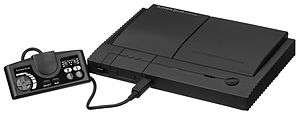 | |
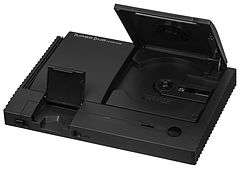 | |
| NEC/Turbo Technologies later released the TurboDuo, which combined the TurboGrafx-CD (with the new Super-System-Card on-board) and TurboGrafx-16 into one unit. | |
NEC Home Electronics released the PC Engine Duo in Japan on September 21, 1991,[1] which combined the PC Engine and Super CD-ROM² unit into a single console. The system can play HuCards, audio CDs, CD+Gs, standard CD-ROM² games and Super CD-ROM² games. The North American version, the TurboDuo, was launched in October 1992. The American version of Duo was originally bundled with one control pad, an AC adapter, RCA cables, Ys Book I & II (a CD-ROM² title), and a Super CD-ROM² including Bonk's Adventure, Bonk's Revenge, Gate of Thunder and a secret version of Bomberman accessible via a cheat code. The system was also packaged with one random HuCard game which varied from system to system (Dungeon Explorer was the original HuCard pack-in for TurboDuo, although many titles were eventually used, such as Irem's Ninja Spirit and Namco's Final Lap Twin, and then eventually a random pick).
Two updated variants were released in Japan: the PC Engine Duo-R (on March 25, 1993)[1] and the PC Engine Duo-RX (on June 25, 1994).[1] The changes were mostly cosmetic, but the RX included a new 6-button controller.
Third-party models
The PC-KD863G is a CRT monitor with built-in PC Engine console, released on September 27, 1988 in Japan for ¥138,000. Following NEC's PCs' naming scheme, the PC-KD863G was designed to eliminate the need to buy a separate television set and a console. It output its signals in RGB, so it was clearer at the time than the console which was still limited to RF and composite. However, it has no BUS expansion port, which made it incompatible with the CD-ROM² System and memory backup add-ons
The X1-Twin was the first licensed PC Engine-compatible hardware manufactured by a third-party company, released by Sharp in April 1989 for ¥99,800.[28] It is a hybrid system that can run PC Engine games and X1 computer software.
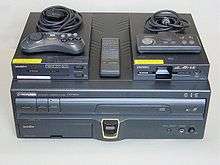
Pioneer Corporation's LaserActive supports an add-on module which allows the use of PC Engine games (HuCard, CD-ROM² and Super CD-ROM²) as well as new "LD-ROM²" titles that work only on this device. NEC also released their own LaserActive unit (NEC PCE-LD1) and PC Engine add-on module, under an OEM license.[29] A total of eleven LD-ROM2 titles were produced, with only three of them released in North America.
Other foreign markets
Outside North America and Japan, the TurboGrafx-16 was released in South Korea by a third party company, Haitai, under the name Vistar 16. It was based on the American version but with a new curved design.[30] Daewoo Electronics distributed the PC Engine Shuttle into the South Korean market as well. The PC Engine was never officially released in continental Europe, but some companies imported them and made SCART conversions on a moderate scale. In France, Sodipeng imported Japanese systems and added an RGB Cable called "AudioVideo Plus Cable". This mod improved the original video signal quality extensively and made the consoles work with SECAM televisions. In Germany, several importers sold converted PC Engines with PAL RF as well as RGB output. The connectors and pinouts used for the latter were frequently compatible with the Amiga video port, with two unconnected pins used for the audio channels.
Peripheral compatibility
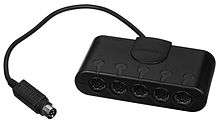
All PC Engine systems support the same controller peripherals, including pads, joysticks and multitaps. Except for the Vistar, Shuttle, GT, and systems with built-in CD-ROM drives, all PC Engine units shared the same expansion connector, which allowed for the use of devices such as the CD-ROM unit, battery backup and AV output.
The TurboGrafx and Vistar units use a different controller port than the PC Engines, but adaptors are available and the protocol is the same. The TurboGrafx offers the same expansion connector pinout as the PC Engine, but has a slightly different shape so peripherals must be modified to fit.
The Arcade Card Pro is designed for the original CD-ROM² System add-on, adding the 2304 kB of RAM required by Arcade CD-ROM² games. The Arcade Card Duo is for the Super CD-ROM² System and the PC-Engine Duo/R/RX consoles and adds 2048 kB RAM, since those systems already have 256K of RAM built-in.
The various CD-ROM game types are:
- CD-ROM² : Standard CD-ROM game. Runs on all CD-ROM² Systems without any additional requirements
- Super CD-ROM² : Requires a Super System Card to work on the original CD-ROM² System. No card is required for Super CD-ROM² and Duo consoles.
- Arcade CD-ROM² : Requires an Arcade Card Pro on the original CD-ROM² System, or an Arcade Card Duo on the Super CD-ROM² and Duo consoles.
Video formats
All PC Engine hardware outputs video in NTSC format, including the European TurboGrafx; it generates a PAL-compatible video signal by using a chroma encoder chip not found in any other system in the series.
Technical specifications
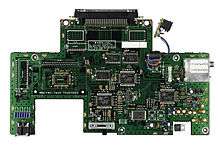
The PC Engine is a relatively compact video game console, owing to an efficient three-chip architecture and its use of small ROM cartridges called HuCards (Turbo Chips in North America). Hudson Soft developed the HuCard (Hudson Card) from the Bee Card technology it piloted on the MSX. HuCards are about the size of a credit card, but slightly thicker. They are very similar to the My Card format utilized for certain games released on the SG-1000/SC-3000 and the Mark III/Master System. The largest Japanese HuCard games were up to 20 Mbit in size. All PC Engine consoles can play standard HuCards, including the PC Engine SuperGrafx (which has its small library of exclusive HuCards).
With the exception of the budget-priced PC Engine Shuttle, the portable PC Engine GT and the PC-KD863G monitor, every PC Engine console is also capable of playing CD-ROM² discs, provided the console is equipped with the required CD-ROM drive and System Card. The SuperGrafx and PC Engine LT both required additional adapters to work on the original CD-ROM² System and Super CD-ROM² respectively, whereas the Duo consoles had the CD-ROM drive and Super System Card integrated into them (as did the Super CD-ROM² player). Some unlicensed CD games by Games Express can only run on Duo consoles, due to their games requiring both a special System Card packaged with the games and the 256 kB of RAM built into the Duo.
The console's CPU is a Hudson Soft HuC6280 8-bit microprocessor operating at 1.79 MHz and 7.16 MHz. It features integrated bank-switching hardware (driving a 21-bit external address bus from a 6502-compatible 16-bit address bus), an integrated general-purpose I/O port, a timer, block transfer instructions, and dedicated move instructions for communicating with the HuC6270A VDC. Its 16-bit graphics processor and video color encoder chip were also developed by Hudson Soft.[32] It holds 8 kB of work RAM and 64 kB of video RAM.
Display
Resolution
- X (Horizontal) Resolution: variable, maximum of 565 (programmable to 282, 377 or 565 pixels, or as 5.3693175 MHz, 7.15909 MHz, and 10.738635 MHz pixel dot clock)[33] Taking into consideration overscan limitations of CRT televisions at the time, the horizontal resolutions were realistically limited to something a bit less than what the system was actually capable of. Consequently, most game developers limited their games to either 256, 352, or 512 pixels in display width for each of the three modes.[34]
- Y (Vertical) Resolution: variable, maximum of 242 (programmable in increments of 1 scanline). It is possible to achieve an interlaced "mode" with a maximum vertical resolution of 484 scanlines by alternating between the two different vertical resolution modes used by the system. However, it is unknown, at this time, if this interlaced resolution is compliant with (and hence displayed correctly on) NTSC televisions.
- The majority of TurboGrafx-16 games use 256×239,[33] though some games, such as Sherlock Holmes: Consulting Detective did use 512×224.
Color
- Colors available: 512 (9-bit)
- Colors onscreen: Maximum of 482 (241 background, 241 sprite)
- Palettes: Maximum of 32 (16 for background tiles, 16 for sprites)
- Colors per palette: 16 per background palette (color entry #0 of each background palette must be the same), and 15 per sprite palette (plus transparent, which is displayed as an actual color in the overscan area of the screen)
Sprites
- Simultaneously displayable: 64 on-screen, 16 (256 sprite pixels) per scanline
- Sizes: 16×16, 16×32, 16×64, 32×16, 32×32, 32×64
- Palette: Each sprite can use up to 15 unique colors (one color must be reserved as transparent) via one of the 16 available sprite palettes.
- Layers: The HuC6270A VDC was capable of displaying one sprite layer. Sprites could be placed either in front of or behind background tiles by manipulating a bit which caused indirect pixel color entry #0 of the background tile(s) to act as transparent.
Tiles
- Size: 8×8
- Palette: Each background tile can use up to 15 unique colors via one of the 16 available background palettes and 1 shared color (BG color #0) for a total of 16 colors per tile. The first color entry of each background subpalette is ignored. Instead, color #0's RGB value is shown in its place (the common/shared color). When a specific sprite is set to show behind the BG layer via the priority bit, all tiles that use relative color #0 (of 16) will not show BG color #0. But instead will show the sprite pixel (if not opaque).
- Layers: The HuC6270A VDC was capable of displaying one background layer.
Audio capacity
- Six wavetable synthesis audio channels, programmable through the HuC6280A CPU.
- Each channel had a frequency of 111.87 kHz for single cycle of 32 samples (while not in D/A mode) with a bit depth of 5 bits. Each channel also was allotted 20 bytes (32×5 bits) of RAM for sample data.
- The waveforms were programmable so the composers were not limited to the standard selection of waveforms (square, sine, sawtooth, triangle, etc.). But standard and semi-standard waveforms, such as a 25% pulse wave, were used fairly often.
- The first two audio channels (1 and 2) were capable of LFO when channel #2 was used to modulate channel #1 with vibrato.
- The last two audio channels (5 and 6) were capable of noise generation.
- Optional software enabled Direct D/A which allows for sampled sound to be streamed into any of the six PSG audio channels. When a channel is in D/A mode the frequency is as fast as the CPU can stream bytes to the port, though in practicality it is limited to 6.99 kHz when using the TIMER interrupt with its smallest loop setting (1023 cpu cycles) or 15.7 kHz using the scanline interrupt.
- There is a method that combines two channels in DDA mode to play back 8-bit, 9-bit, or 10-bit samples.
- The addition of the CD-ROM peripheral adds CD-DA sound, and a single ADPCM channel to the existing sound capabilities of the PC Engine.
Region protection

With HuCards, a limited form of region protection was introduced between markets which for the most part was nothing more than running some of the HuCard's pinout connections in a different arrangement. There were several major after-market converters sold to bypass this protection, and were sold predominantly for use in converting Japanese titles for play on a TG-16. In the Japanese market, NEC went further by adding a hardware level detection function to all PC Engine systems that detected if a game was a U.S. release, and would then refuse to play it. The only known exception to this is the U.S. release of Klax which did not contain this function. The explanation commonly given for this by NEC officials is that most U.S. conversions had the difficulty level reduced, and in some cases were censored for what was considered inappropriate content, and consequently, they did not want the U.S. conversion to re-enter the Asian market and negatively impact the perception of a game. With some minor soldering skills, a change could be made to PC Engines to disable this check.[35] The only Japanese games that could not be played on a U.S. system using one of these converters were the SuperGrafx titles which could only be played on a SuperGrafx.
There was no region protection on TurboGrafx-CD and CD-ROM² System games.
Due to the extremely limited PAL release after NEC decided to cancel a full release, there were no PAL HuCards made. The European TurboGrafx therefore played the NTSC American/Japanese titles, converted to PAL 50 Hz format.[6]
CD hardware technical specifications and information
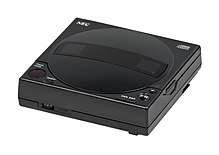
- Oki MSM5205 ADPCM chip with variable speed input clock, and 64 kB DRAM for audio sample storage. Only one channel of 4-bit compressed audio (decompresses to 12-bit, top 10 bits output through DAC) was supported.[36] It supports a sampling rate of up to 32.088 kHz.[37]
- Programmable, timer controlled, electronic volume attenuator to fade-out the CD-DA and ADPCM audio channels together or individually.
- The PC-Engine CD-ROM interface tray has 64 kB of DRAM for storage of program code and data loaded from the CD.
- The "System Card" contains the BIOS program used to boot CD media and provides functions for software to access CD hardware through a standardized interface. Later System Cards had extra RAM and updates to the BIOS.
- The Duo series has the same BIOS ROM (v3.00) and RAM (256 kB total) as a PC-Engine system equipped with a Super System Card. The Duo implements the memory as a single 256 kB SRAM chip rather than the split 64 kB DRAM / 192 kB SRAM.
- The list of known CD-ROM BIOS revisions are:
- v1.00 – First release (System Card, came with the first versions of the PC-Engine CD-ROM² Interface Unit)
- v2.00 – Upgrade (System Card, came with later versions of the Interface Unit)
- v2.10 – Upgrade (System Card, came with even later versions of the Interface Unit or sold separately)
- v3.00 – Final release (built into several products and available as a Super System Card – see below)
- The list of known System Card releases are:
- System Card v1.00 – First release. Came packaged with the original PC-Engine CD-ROM² System.
- System Card v2.00 – BIOS update. This adds support for CD+G discs.
- System Card v2.10 – BIOS update. Auto disc change detection is implemented. Was the first System Card that was sold separately from the add-on.
- System Card v3.00 (aka. Super System Card) – 1.5 Mbit RAM (192 kB) – RAM upgrade and BIOS update. This expands the RAM available for the CD-ROM unit to 256 kB when including the existing built in DRAM. It also offers a final BIOS update to v3.00. The PC-Engine Duo (Turbo Duo in North America) had 256 kB of RAM and the same v3.00 BIOS built into the system. Games developed for this System Card bore the "Super CD-ROM² System" mark and could not be played using an older System Card.
- Arcade Card Duo – 16 Mbit RAM (2048 kB) – RAM upgrade exclusively for the Super CD-ROM² System and PC Engine Duo consoles. This greatly expands the RAM available to 2048 kB. The BIOS revision was unchanged from v3.00. Games developed for the Arcade Card Duo/Pro bore the "Arcade CD-ROM²" mark, and could not be played using prior System Cards.
- Arcade Card Pro – 17.5 Mbit RAM (2240 kB as 2 MB+192 kB) – RAM upgrade for the original CD-ROM² System. This greatly expands the RAM available to 2240 kB. The BIOS revision was unchanged from v3.00. The Arcade Card Pro combines the functions of the Super System Card and the Arcade Card Duo into one unit. The 2 MB of RAM is accessed through ports or units of single 8 kB banks and is intended for graphics data storage rather than program code; its flexible addressing system allows for rapid transfer of data to VRAM. While intended and marketed for the original CD-ROM² System, it's actually compatible with Super CD-ROM² add-on and all Duo consoles without any issues.
- Games Express CD Card – Bootleg System Card. This was released by Hacker International for play of unlicensed Games Express CD games. The GECD Card is essentially a dongle; a BIOS v3.00 based machine (like a Duo or a Super CD-ROM²) is required for running those games.
Corresponding CD-ROM products
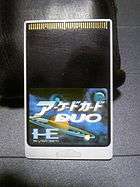 |
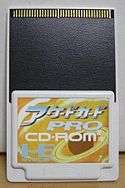 |
| Arcade Card Duo (left) and Arcade Card Pro | |
- CD-ROM² System – Consists of two components: a compact CD player (CDR-30) and the Interface Unit (IFU-30), which connects the CD player into the PC Engine console itself. These were sold separately or as part of a bundle. The Interface Unit also stores save data and provides a common power supply for the PC Engine and the CD player. A System Card is required for the PC Engine to access the functions of the CD player. Later revisions of both, the CD player (CDR-30A) and the Interface Unit (IFU-30A), featured improved disc reading capabilities.
- System Card – The original CD-ROM² System Card included with the Interface Unit. The System Card underwent a few slight revisions, with Version 1.0 being the original model, followed by Version 2.0 (which adds CD+G support) and Version 2.1 (which auto-detects discs). Only Version 2.1 was sold as a stand-alone unit.
- ROM² Adaptor (RAU-30) – A cable with two large ends that allows a PC Engine SuperGrafx (PI-TG4) console to be connected into the CD-ROM² Interface Unit.
- Super System Card (PI-SC1) – An upgraded System Card that changes the BIOS of the CD-ROM² System to Version 3.0 and adds the 192kb of SRAM required to play Super CD-ROM² format discs.
- Super CD-ROM² (PI-CD1) – An upgraded version of the CD-ROM² System add-on that combines the functions of the Interface Unit, CD-ROM player and Super System Card into one unit.
- PC Engine Duo (PI-TG8) – A PC Engine console with a built-in Super CD-ROM² unit.
- Super ROM² Adaptor (PI-AD18) – An adapter that allows the PC Engine LT (PI-TG9) to be connected into the Super CD-ROM² unit.
- PC Engine Duo-R (PI-TG10) – A redesigned version of the PC Engine Duo.
- PC Engine Duo-RX (PCE-DUORX) – The third version of the PC Engine Duo.
- Arcade Card Duo (PCE-AC1) – A RAM expansion card that adds the 16 Megabits of DRAM required to run Arcade CD-ROM² discs on any Super CD-ROM² and PC Engine Duo systems.
- Arcade Card Pro (PCE-AC2) – Combines the functions of the Arcade Card Duo and the Super System Card into one card. Designed and marketed primarily for the original CD-ROM² System.
Drive unit
- Single-speed CD-ROM drive, managed by an NEC microcontroller and using the SCSI-I interface.
- Transfer rate of 150 kB/s.
Reception
In Japan, the PC Engine was very successful, and at one point was the top-selling console in the nation.[38] In North America and Europe the situation was reversed, with both Sega and Nintendo dominating the console market at the expense of NEC. Initially, the TurboGrafx-16 sold well in the U.S., but eventually it suffered from lack of support from third-party software developers and publishers.
In 1990, ACE magazine praised the console's racing game library, stating that, compared to "all the popular consoles, the PC Engine is way out in front in terms of the range and quality of its race games."[39] Reviewing the Turbo Duo model in 1993, GamePro gave it a "thumbs down". Though they praised the system's CD sound, graphics, and five-player capability, they criticized the outdated controller and the games library, saying the third party support was "almost nonexistent" and that most of the first party games were localizations of games better suited to the Japanese market.[40] In 2009, the TurboGrafx-16 was ranked the 13th greatest video game console of all time by IGN, citing "a solid catalog of games worth playing," but also a lack of third party support and the absence of a second controller port.[41]
The controversy over bit width marketing strategy reappeared with the advent of the Atari Jaguar console. Mattel did not market its 1979 Intellivision system with bit width, although it used a 16-bit CPU.[7]
Legacy
In 1994, NEC released a new console, the Japan-only PC-FX, a 32-bit system with a tower-like design; it enjoyed a small but steady stream of games until 1998, when NEC finally abandoned the video games industry. NEC supplied rival Nintendo with the RISC-based CPU, V810 (same one used in the PC-FX) for the Virtual Boy and VR4300 CPU for the Nintendo 64, released in 1995/1996, and former rival Sega with a version of its PowerVR 2 GPU for the Dreamcast, released in 1998.
NEC supplied Bandai's WonderSwan handheld console, which was developed by Gunpei Yokoi, with the V30 MZ CPU. In 2000s, NEC manufactures dynamic RAM process chip and produced for the GameCube GPU, Flipper, a graphics card development by ArtX.
A number of TurboGrafx-16 and TurboGrafx-CD games were released on Nintendo's Virtual Console download service for the Wii,[42] Wii U, and Nintendo 3DS, including several that were originally never released outside Japan.[43][44] In 2011, ten TurboGrafx-16 games were released on the PlayStation Network for play on the PlayStation 3 and PlayStation Portable in the North American region.
In 2010 Hudson released an iPhone application entitled "TurboGrafx-16 GameBox" which allowed users to buy and play a number of select Turbo Grafx games via in-app purchases.[45]
In 2016, rapper Kanye West's 8th solo album was initially announced to be titled "Turbo Grafx 16".[46][47] The title, however, was later changed to Ye.
In 2019, Konami announced at E3 2019 the TurboGrafx-16 Mini,[48] a dedicated console featuring many built-in games.[49] It's the first release of official hardware of the TurboGrafx-16 family since the closure of Hudson Soft in 2012. On March 6, 2020, Konami announced that the TurboGrafx-16 Mini and its peripheral accessories will be delayed indefinitely from its previous March 19, 2020, launch date due to the COVID-19 outbreak in China.[50][51][52]
Emulation
Emulation programs for the TurboGrafx-16 exist for several modern platforms, such as Wii U homebrew launcher and retro operating systems and architectures and are at varying levels of emulation ranging from beta stage, to near perfect emulation of all PC Engine and TurboGrafx-16 formats.
See also
References
- "PC-Engine". Pc-engine.co.uk. Archived from the original on June 7, 2019. Retrieved December 25, 2017.
- "ウィークエンド経済 第765号 あの失敗がこう生きた [Weekend Economics Issue 765. That Mistake Lived On.]". Asahi Shinbun (Evening Edition) (in Japanese). Osaka, Japan. December 1, 2001.
- Japanese: PCエンジン Hepburn: Pī Shī Enjin
- Guinness World Records Gamer's Edition (2008)
- McFerran, Damien (November 2, 2012). "Feature: The Making Of The PC Engine". Nintendo Life. Archived from the original on July 30, 2019.
- Nutt, Christian (September 12, 2014). "Stalled engine: The TurboGrafx-16 turns 25". Gamasutra. Archived from the original on June 27, 2017.
- Therrien, Carl; Picard, Martin (April 29, 2015). "Enter the bit wars: A study of video game marketing and platform crafting in the wake of the TurboGrafx-16 launch". New Media & Society. 18 (10): 2323–2339. doi:10.1177/1461444815584333.
- Sartori, Paul (April 2, 2013). "TurboGrafx-16: the console that time forgot (and why it's worth re-discovering)". The Guardian. Archived from the original on July 1, 2018.
- Stuart, Keith; Freeman, Will (February 27, 2016). "Why Kanye West is right to recommend the TurboGrafx-16". The Guardian. Archived from the original on June 22, 2017. Retrieved December 25, 2017.
- Video Game Trader Magazine (March 16, 2009). "Video Game Trader #3, March 2008". Videogametrader.com. Archived from the original on July 17, 2011. Retrieved July 5, 2011.
- Kent, Steve L. (October 2, 2001). The Ultimate History of Video Games. Three Rivers Press. p. 413. ISBN 0-7615-3643-4. LCCN 2001036497.
- "Hudson Entertainment – Video Games, Mobile Games, Ringtones, and More!". June 19, 2008. Archived from the original on September 29, 2011. Retrieved July 5, 2011.
- "Nec PC Engine / Turbografx". September 1, 2000. Archived from the original on February 5, 2017. Retrieved January 26, 2016.
- "Pubs Sodipeng Pc-engine (1990-91) - Le Adra's Blog !". Gameblog. Retrieved December 25, 2017.
- "Oldies #11 – PC Engine SuperGrafx (Nec)". Retroblog.fr. Archived from the original on November 12, 2017. Retrieved December 25, 2017.
- "Celebrating Software". Computer Gaming World. June 1991. p. 64. Retrieved November 17, 2013.
- "At the Deadline". GamePro (60). IDG. July 1994. p. 172.
- "Dead of the Brain 1 & 2". Consolecity.com. June 3, 1996. Retrieved July 5, 2011.
- シーディーロムロム Shī Dī Romu Romu
- "Turbo CD". GameFAQs. Retrieved May 14, 2012.
- "[I ♥ The PC Engine] Fighting Street @ Magweasel". magweasel.com. Retrieved December 25, 2017.
- "No-Ri-Ko (Game) - Giant Bomb". Giant Bomb. Retrieved December 25, 2017.
- Top 25 Videogame Consoles of All Time, IGN. Retrieved June 14, 2010
- Wolf, Mark J. P. (2008). The video game explosion: a history from PONG to Playstation and beyond. ABC-CLIO. p. 119. ISBN 978-0-313-33868-7. Retrieved April 10, 2011.
- "TurboGrafx-CD System" (PDF). Computer Entertainer. Vol. 8 no. 9. December 1989. p. 11. Archived (PDF) from the original on September 25, 2018.
- "Toys R Us weekly ad". The Catoosa County News. December 5, 1990. Retrieved June 17, 2014.
- スーパーシーディーロムロム Sūpā Shī Dī Romu Romu
- "スーパーPCエンジンファン" [Super PC Engine Fan] (in Japanese). Vol. 1. Tokuma Shoten Intermedia. January 15, 1994. Cite magazine requires
|magazine=(help) - "International News". Electronic Gaming Monthly. No. 54. January 1994. p. 94. Retrieved March 10, 2020.
- "Korean TurboGrafx-16 - The Vistar". nfggames.com. Retrieved December 25, 2017.
- "The Next Generation 1996 Lexicon A to Z: Bit". Next Generation. No. 15. Imagine Media. March 1996. p. 30.
- "United States patent 5059955".
- "Forums.MagicEngine.com". Forums.MagicEngine.com. Retrieved July 5, 2011.
- "forum". Pcenginefx.com. Retrieved July 5, 2011.
- "PC Engine Import Mod". GameSX. Retrieved January 11, 2014.
The fix: On Japanese systems, connect pin 29 of the Hu6280 chip to [ground]. That's it.
- "MSM5205 - ArchaicPixels: HuC and PCEAS Documentation". Ysutopia.net. Retrieved December 25, 2017.
- "What in the Name of Sam Hill is a PC Engine?". Electronic Gaming Monthly. Ziff Davis (70): 15. May 1995.
- ACE, issue 34 (July 1990), page 59
- "System Shopper". GamePro (53). IDG. December 1993. pp. 46–49.
- "TurboGrafx-16 is number 13". IGN. Retrieved July 5, 2011.
- "Hudson Entertainment – Video Games, Mobile Games, Ringtones, and More!". Hudsonent.com. Archived from the original on July 2, 2017. Retrieved July 5, 2011.
- "GDC 06: Satoru Iwata Keynote". IGN. March 23, 2006. Archived from the original on August 9, 2006. Retrieved July 5, 2011.
- "Virtual Console: Sega and Hudson games are a go! – Nintendo Wii Fanboy". Revolution Fanboy. March 23, 2006. Archived from the original on December 1, 2008. Retrieved July 5, 2011.
- Cowan, Danny (December 21, 2010). "Hudson Releases TurboGrafx-16 GameBox Emulator For iOS". Gamasutra. Archived from the original on July 12, 2016. Retrieved April 6, 2016.
- West, Kanye [@kanyewest] (February 26, 2016). "My next album is titled "Turbo Grafx 16" as of now…" (Tweet). Archived from the original on June 14, 2016 – via Twitter.
- Byford, Sam (February 27, 2016). "Kanye West says his new album is called Turbo Grafx 16 and coming this summer". The Verge. Archived from the original on September 6, 2018. Retrieved April 6, 2016.
- "PC Engine mini, PC Engine CoreGrafx mini, TurboGrafx-16 mini Official Website".
- Lanier, Liz (June 12, 2019). "Konami Releasing a Mini Version of TurboGrafx-16 With Pre-Loaded Games". Variety. Archived from the original on March 10, 2020. Retrieved March 10, 2020.
- Batchelor, James (March 6, 2020). "TurboGrafx-16 Mini indefinitely delayed due to coronavirus". GamesIndustry.biz. Archived from the original on March 7, 2020. Retrieved March 10, 2020.
- Yin-Poole, Wesley (March 6, 2020). "Konami delays PC Engine Core Grafx mini over coronavirus". Eurogamer. Archived from the original on March 10, 2020. Retrieved March 10, 2020.
- @konamieu (March 6, 2020). "[Notice] We have added the notice "Regarding the manufacturing and shipping delays of the PC Engine Core Grafx mini products due to the Coronavirus disease (COVID-19)" to the official website. Check here for more details: konami.com/games/pcemini/eu/en/ #CoreGrafx" (Tweet) – via Twitter.
External links
| Wikimedia Commons has media related to PC Engine. |
- The PC Engine Software Bible software listing including reviews and videos.
- PC-Engine definitive hardware listing for all PC Engine and Turbo Grafx systems.
- Archaic Pixels contains the most extensive compendium of TurboGrafx-16 technical information.
- TurboGrafx-16 overview and review show!
- Video of TurboGrafx-16 and PC Engine hardware and features from FamicomDojo.TV